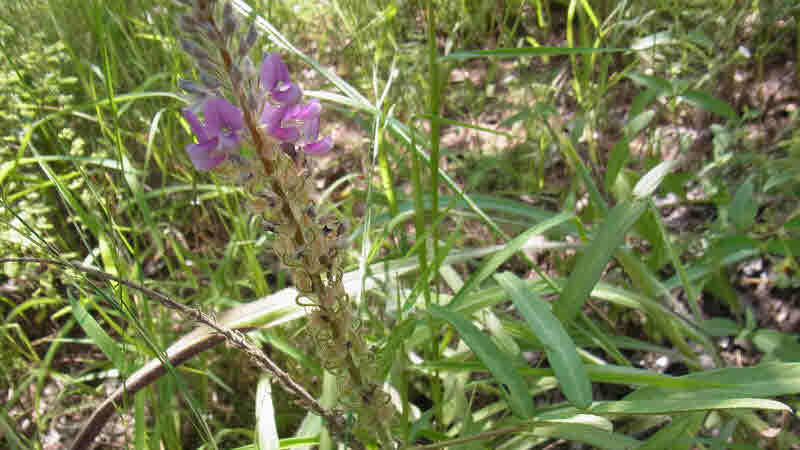Prishniparni is a well-known medicinal herb of Ayurveda. This herb is found in India (Bihar, Orissa, West Bengal), Nepal, China and Northern Australia. In Ayurveda, it is used in the treatment of asthma, dysentery, delirium, ulcers, malarial fevers, fractures of bones, inflammation of chest and diarrhea, catarrhs, bleeding piles and many other ailments. The roots of the plants mainly contain alkaloids, saponins, flavonoids, glycosides, proteins, steroids, tannins and phytosterols.

It is one of the root of Laghu panchamula in Dashamoola ( a combination of roots of ten medicinal plants = Brihatpanchamula + Laghupanchamula). Dashamoola is a standard Ayurvedic remedy for inflammatory conditions.
For the medicinal purpose the roots, leaves and whole plant is used. Leaves have antiseptic properties. They are used traditionally in the treatment of wounds, genitourinary infections and urinary disorders. The powdered leaves of this plant are used for gonorrhea. The plant is also used in heart troubles. The plant is also used as an antidote against the bites of certain vipers, scorpions.
The roots of the plants have aphrodisiac, the liver protecting, anti-inflammatory (swelling reducing), antithrombotic (reduces the formation of blood clots/thrombi), antimicrobial and anti-diarrheal properties. The roots are used for fracture healing due to its property of accumulation of phosphorous and deposition of calcium.
General Information
Scientific Classification
The botanical name of Prishniparni is Uraria picta. It belongs to plant family Papilionaceae;Fabaceae. Below is given taxonomical classification of the plant.
- Kingdom: Plantae
- Phylum: Tracheophyta
- Class: Magnoliopsida
- Order: Fabales
- Family: Fabaceae
- Genus: Uraria
- Species: Uraria Picta
Synonym(s):
- Doodia picta Roxb
- Hedysarum pictum Jacq
- Uraria aphrodisiaca Welw
- Uraria leucantha Span
- Uraria linearis Hassk
Other related species known as Prishniparni
- Uraria alopecuroides Wight (Papilionaceae, Fabaceae)
- Uraria crinita Desv. (Papilionaceae, Fabaceae)
- Uraria lagopoides (Papilionaceae, Fabaceae)
Part(s) used for medicinal purpose: Roots, leaves, whole plant
Plant type: undershrub
Distribution: Throughout India, in dry grasslands.
Habitat and Ecology: found in areas of grassland, grassland with scattered trees including Acacia grassland;on rocky ground, deep sandy soils;by riverbanks, floodplains and gallery forest.
Vernacular names/Synonyms
- Ayurvedic: Prishniparni, Prithakparni, Simhapushpi, Kalashi, Dhaavani, Guhaa, Chitraparni
- Siddha/Tamil: Oripai
- Bengali: Salpani, Chhalani, Chakule
- Gujrati: Pithavan
- Hindi: Pithavan, Dabra
- Kannada: Murele Honne, Ondele honne, Prushniparni
- Malayalam: Orila
- Marathi: Pithvan, Prushnipamee
- Oriya: Prushnipamee, Shankarjata
- Punjabi: Detedarnee
- Tamil: Oripai
- Telugu: Kolakuponna
Dosage
Powder of whole plant is taken in amount of 20-50 grams for preparing decoction.
Ayurvedic Properties and Action of Whole Plant
Rasa (taste on the tongue): Madhura (Sweet), Katu (Pungent), Amla (Sour), Tikta (Bitter)
Guna (Pharmacological Action): Laghu (Light), Sara (Unstable)
Virya: Ushna (Heating)
Vipaka (transformed state after digestion): Madhura
Action:
Deepan, Sangrahi, Tridoshhar, Vata-har, Vrishya, shothhar, Balvardhak
Important formulations
- Amritarishta Ayurvedic medicine is beneficial in all type of fever, chronic fever, malaria, recurring fevers and accompanying complaints of enlarged the liver of the spleen or digestive disturbances, night sweating, and weakness.
- Angamarda Prashamana Kashaya Curna
- Dashamula Taila is used externally for massaging body. It is good for the skin and can be used by everyone. It helps to cure skin problems, pain caused due to vaat and kapha imbalance.
- Vyaghritaila
- Dashamularisha nourishes the body and gives strength. It is good for reproductive system of both males and females. It and improves fertility.
Therapeutic uses
Diarrhea/Atisar, vomiting/Chardi, burning sensation, fever, cough, bloody dysentery, insanity, gout, bleeding piles, excessive thirst, diseases of eyes and fracture.
Medicinal Uses of Prishniparni
The decoction of whole plant is used in diseases due to vitiated blood, gout, bleeding piles, blood dysentery, acute diarrhea alcoholism, insanity, psychosis, cough, bronchitis and difficult breathing. The plant is used for treating fractures.
In scientific studies, the plant extract shows better healing of fractures due to early accumulation of phosphorus and more deposition of calcium.
Prishniparni is Tridoshahara. It is a tonic. It Deepana दीपन (promote appetite but do not aid in digesting undigested food). It reduces swelling and fever. It improves strength and gives relief in gout.
Cold:For cold, boil 10-20 grams of powder of whole plant in 400 ml of water. Boil it till it becomes 1/4 of original quantity. Filter this decoction. Add some sugar and drink lukewarm.
Bony Fracture:Take Prishniparni root powder 5 grams + turmeric 2 grams. Do regularly for one month.
Poison:Fresh juice of whole plant taken in a dose of 10-30 ml gives relief.
Spleen enlargement, Liver and abdominal diseases: Boil 10-20 grams of powder of whole plant in 400 ml of water. Boil it till it becomes 1/4 of original quantity. Filter this decoction. Add some sugar and drink.
What about the it’s use for treating sterile women. Do you use the leave paste or paste made from the flowers
Comment: great information and well artictlated